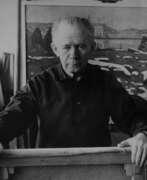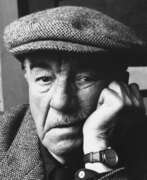Industrial landscape Europe


Aleksey Kuzmich Denisov-Uralsky (Russian: Алексей Кузьмич Денисов-Уральский) was a Russian artist and stonecutter, born in 1864 and known for his exceptional landscape paintings and intricate stone carvings. He made significant contributions to both the artistic and jewelry worlds, particularly in Russia during the late 19th and early 20th centuries.
Denisov-Uralsky's works are celebrated for their meticulous craftsmanship and vibrant use of color. His paintings often depicted the serene landscapes of the Ural Mountains, capturing their natural beauty with a delicate touch. Notable pieces include "River Landscape" and "Author's Boat by the High Wooded Bank of the Chusovaya," both of which have fetched impressive prices at auctions, reflecting their enduring appeal.
In addition to his paintings, Denisov-Uralsky was renowned for his work with semi-precious stones. He founded a prominent firm in St. Petersburg, where he created exquisite jewelry and decorative items. One of his famous works, an imperial hardstone figure of a parrot, showcases his ability to transform natural stones into lifelike sculptures. This piece was even purchased by Dowager Empress Maria Feodorovna, underscoring its high value and artistry.
Collectors and art enthusiasts continue to admire Denisov-Uralsky's legacy, which combines the elegance of Russian landscapes with the precision of fine stonework. His works remain sought after at auctions and are displayed in various prestigious collections worldwide.
For updates on new product sales and auction events related to Aleksey Kuzmich Denisov-Uralsky, sign up for our notifications. Stay informed about opportunities to acquire pieces by this exceptional artist.


Sulo Juntunen (Russian: Суло Хейккиевич Юнтунен) was a Soviet artist of Finno-Ingermanic origin, celebrated for his multifaceted contributions to the art world as both a painter and a graphic artist. Born on September 1, 1915, in Saint Petersburg, Russia, and passing away on November 19, 1980, in Petrozavodsk, USSR, Juntunen's life and career were marked by his deep connection to the landscapes of his homeland and his ability to portray the changing face of society through his art.
His early years were characterized by a diverse set of experiences, from living in Finland with his family to working various jobs upon their return to the Soviet Union. It wasn't until after World War II that Juntunen fully embraced his calling as a painter, joining the Union of Soviet Artists in 1946 and becoming a significant figure in the art community, especially within the Karelian region. Juntunen's work is renowned for its detailed portrayal of modern urban and industrial landscapes, as well as the serene beauty of unspoiled nature. His artistic journey reflects a transition from detailed Soviet landscapes to a more laconic and strict drawing style, culminating in panoramic landscapes primarily focused on Karelia in his later years.
Juntunen's achievements in the art world were recognized with numerous titles, including Honored Worker of Arts of the Karelian ASSR in 1953, Honored Worker of Arts of Russia in 1959, and People's Artist of the USSR in 1980. His work has been exhibited widely, both within the USSR and internationally, and is part of the collections of major museums such as the Tretyakov Gallery, the Russian Museum, and even the Museum of Realistic Arts in Utah, USA.
For collectors and experts in art and antiques, Sulo Juntunen's work offers a rich tapestry of Soviet and Finnish history, depicted through the lens of an artist who skillfully navigated between two worlds. His legacy continues to inspire and intrigue those passionate about the art of the 20th century.
If you're interested in staying updated on new discoveries, sales, and auction events related to Sulo Juntunen, sign up for our updates. This subscription is your gateway to the latest information, ensuring you're always informed about opportunities to engage with the work of this remarkable artist.


Joseph Fernand Henri Léger was a French artist renowned for his innovative approach to Cubism and his transition towards a figurative, populist style. Born in Argentan, Orne, Lower Normandy, Léger's early career was marked by a stint as an architectural draftsman and a series of educational pursuits that eventually led him to Paris, where he embraced painting seriously. His artistic journey was significantly influenced by the bold abstractions of Cubism, characterized by geometric shapes and a vibrant palette, distinguishing his work from his contemporaries with what came to be known as "Tubism".
Léger's service in World War I profoundly impacted his artistic direction, leading him to adopt a 'mechanical' style that depicted the modern industrial world with sleek, tubular forms. This period saw creations like "Soldier with a Pipe" and "The Card Players," reflecting his war experiences and the mechanical aesthetics of the time. The post-war era encouraged Léger to explore the mechanical style further, evident in works like "The Bargeman" and "Mechanical Elements," highlighting the pace of technological advancement.
Throughout his career, Léger's work evolved, notably in the 1920s, where he aligned with Purist ideas, blending classicism with modernity. This phase is exemplified in "Woman with a Cat," showcasing a classical form with a modern, polished finish. By the 1930s, Léger's art took a more figurative, populist turn, aiming to democratize contemporary art and make it more accessible. His commitment to art education, especially for the common worker, underscored his belief in the social role of art.
For those intrigued by Joseph Fernand Henri Léger's groundbreaking contributions to modern art, his works can be found in prestigious museums worldwide. His legacy continues to inspire art collectors and enthusiasts alike. To stay updated on exhibitions and auction events featuring Léger's work, sign up for updates and embrace the unique opportunity to explore the richness of his artistic endeavors.


Alexey Shovkunenko (Russian: Алексей Алексеевич Шовкуненко), an eminent Ukrainian and Soviet artist, is celebrated for his vast contributions across painting, graphic arts, and education. His birth on March 21, 1884, in Kherson, within the bounds of the then Russian Empire, and his passing on March 12, 1974, in Kiev, USSR, spanned a timeline of significant historical and artistic evolutions. Renowned for his work in modernist and socialist realism styles, Shovkunenko's repertoire includes landscapes, still lifes, and portraits, crafted through oil, watercolor, and pastel mediums.
His educational journey at the Grekov Odesa Art School and the Saint Petersburg Academy of Arts set the foundation for his illustrious career in both creation and mentorship. Shovkunenko was deeply integrated into the art community, engaging with the Society of South Russian Artists and the Kostandi Society of Artists. His academic roles, notably at the Kyiv State Art Institute, positioned him as a mentor to generations of artists.
Shovkunenko's artwork spans various themes, from the industrial to the intimate. His "Dneprostroy" series, lauded at international exhibitions, and his psychological portraits of significant Ukrainian figures, such as Pavlo Tychyna, Mykola Lysenko, and Oleksandr Bohomolets, underscore his versatility and depth. These works serve not only as artistic expressions but also as historical narratives, capturing the spirit and challenges of his times.
For aficionados of art and antiquities, Shovkunenko's legacy offers a rich tapestry of Eastern European cultural and artistic traditions. His influence, through both his pedagogical endeavors and his diverse body of work, continues to enchant and inspire.
For those keen on delving deeper into Alexey Shovkunenko's remarkable contributions and staying abreast of the latest developments related to his work, including sales and auction events, signing up for updates is highly recommended. This initiative promises to be a gateway to understanding the profound impact and enduring legacy of this distinguished artist.